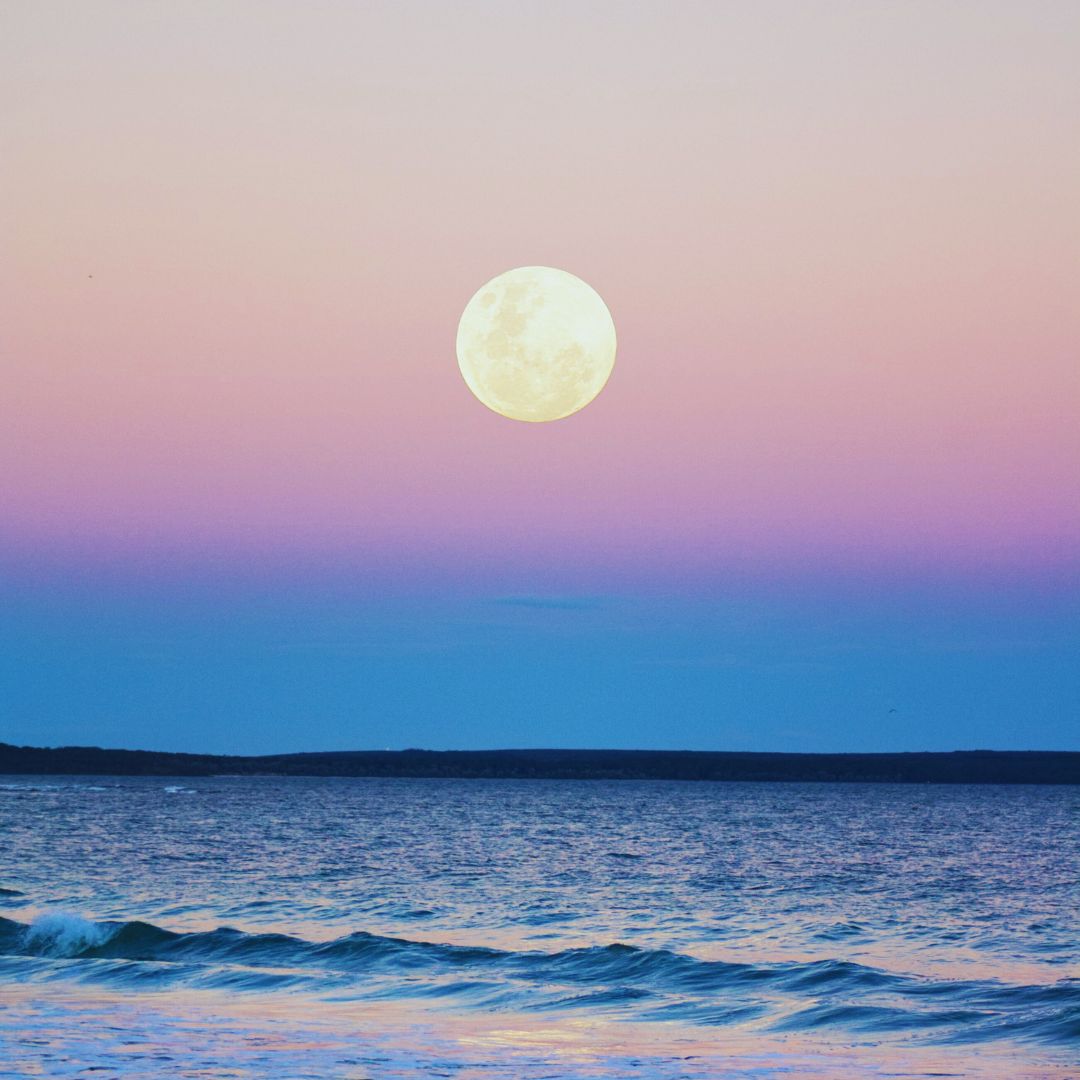Everyone knows and loves the sight of a full Moon rising over a distant horizon (surely?!)
But what is this magical astrological phenomenon, and how do you know when the next Full Moon is on the way…?
What is a full Moon?
A full moon occurs when the visible face of the Moon is completely illuminated by the Sun’s rays, so from Earth it appears round and bright in the night sky.
Full Moons happens each month when the Moon is on the opposite side of Earth from the Sun, meaning its face is fully lit up and visible from Earth.
How often does a full Moon occur?
Full Moons occur roughly every 29.5 days, or a little over every every four weeks. This is how long it takes the Moon to travel through one complete lunar phase cycle, and it means there’s a little over one full Moon for almost each calendar month.
In fact, we experience 13 full moons in a calendar year.
For more detail: How Often is there a Full Moon? (and Why!)
Names and dates of all the full Moons in 2024
- January 25, 2024: Wolf Moon
- February 24, 2024: Snow Moon
- March 25, 2024: Worm Moon
- April 23, 2024: Pink Moon
- May 23, 2024: Flower Moon
- June 21, 2024: Strawberry Moon
- July 21, 2024: Buck Moon
- August 19, 2024: Sturgeon Moon
- September 17, 2024: Harvest Moon
- October 17, 2024: Hunter Moon
- November 15, 2024: Beaver Moon
- December 15, 2024: Cold Moon
January 2024 Full Moon: Wolf Moon
The very first full Moon of the year will rise on Thursday, January 25, 2024, at 11: 57 UTC.
This full Moon occurs at 5º of Leo
The January Full Moon is often known as the Wolf Moon. This name may have Celtic and Old English origins and was brought to North America by European settlers.
The Old Farmer’s Almanac notes that the name comes from Native American Traditions, who noticed that wolves howled in hunger more frequently around this time of year, deep in the cold winter months.
The Wolf Moon is typically the first full Moon of January each year. Its timing in the night sky coincides with the peak of winter, making it an important seasonal marker. Some cultures also associated it with midwinter festivals and spiritual ceremonies during this time.
Other names for the Wolf Moon: Old Moon, Quiet Moon, Ice Moon, Severe Moon
February 2024 Full Moon: Snow Moon
The second full Moon of the year will rise on Saturday, February 24, 2024, at 12:30 UTC.
This full Moon occurs at 5º of Virgo
The February Full Moon is often known as the Snow Moon. It’s believed to earn its name from the heavy snowfall that typically occurs in the northern hemisphere at this time.
Read next: Spiritual Meaning of the Snow Moon
In February, snow can accumulate rapidly and blanket the frozen ground, making for difficult traveling conditions.
Other names for the Snow Moon: Storm Moon, Hunger Moon, Bear Moon
Curious about full Moon rituals?
Read this post next – How to Create a Full Moon Ritual for Manifesting
March 2024 Full Moon: Worm Moon
The third full Moon of the year will rise on Monday, March 25, 2024, at 07:00 UTC.
This full Moon occurs at 5º of Libra and will also be a penumbral lunar eclipse.
The March Full Moon is often known as the Worm Moon. According to The Old Farmer’s Almanac, at this time of year, the ground begins to soften enough for earthworm casts to reappear. The Worm Moon has come to represent the signs of the seasons changing from harsh winter to the arrival of spring.
Read next: Spiritual Meaning of the Worm Moon
Other names for the Worm Moon: Sugar Moon, Sap Moon (after the tapping of maples), Chaste Moon, Death Moon, Crow Moon
April 2024 Full Moon: Pink Moon
The fourth full Moon of the year will rise on Tuesday, April 23, 2024, at 23:48 UTC.
This full Moon occurs at 4º of Scorpio.
The April Full Moon is often known as the Pink Moon. It’s thought that the name of the pink Moon originates with some Native American tribes. It describes the dusky pink colour of the phlox wildflowers that bloom at this time of year.
Also read: Spiritual Meaning of the Pink Moon
Other names for the Pink Moon: Egg Moon, Fish Moon, Budding Moon, Seed Moon, Awakening Moon
Ever tried Moon gazing?
Read this post next – Here’s Why Moon Gazing Could be the Best Thing You’ve Tried All Year!
May 2024 Full Moon: Flower Moon
The fifth full Moon of the year will rise on Thursday, May 23, 2024, at 13:52 UTC.
This full Moon occurs at 2º of Sagittarius.
The May Full Moon is often known as the Flower Moon. It’s thought that the name derives from the fact that the May Full Moon coincides with the blooming of many wildflowers in Northern America. This is described in the Old Farmer’s Almanac.
Other names for the Flower Moon: Hare Moon, Milk Moon, Mothers Moon, Bright Moon, Grass Moon
June 2024 Full Moon: Strawberry Moon
The sixth full Moon of the year will rise on Saturday, June 22, 2024, at 01:07 UTC.
This full Moon occurs at 1º of Capricorn
The June Full Moon is often known as the Strawberry Moon. It likely earned the name, as it often coincides with the peak of the strawberry harvesting season for tribes in North America.
For example, as strawberries ripen and are readily available during late spring and early summer, the Algonquin would time their annual picking and eating of wild strawberries to coincide with this full moon each year.
Other names for the Strawberry Moon: Rose Moon, Red Moon, Honey Moon, Hoe Moon and Planting Moon, Mead Moon, Horse Moon, Planting Moon.
You may also like…
July 2024 Full Moon: Buck Moon
The seventh full Moon of the year will rise on Sunday, July 21, 2024, at 10:16 UTC.
This full Moon occurs at 29º of Capricorn
The July Full Moon is often known as the Buck Moon. It’s believed the name comes from the male deer, or buck, which begins to grow its new antlers around the same time of year that this Full Moon rises.
Many Native American tribes observed deer becoming more active and visible as they searched for mates at this time.
Other names for the Buck Moon: Deer Moon, berry Moon, raspberry Moon, Thunder Moon, Salmon Moon, Hay Moon, Herb Moon
August 2024 Full Moon: Sturgeon Moon
The eighth full Moon of the year will rise on Monday, August 19, 2024, at 18:25 UTC.
This full Moon occurs at 27º of Aquarius, and is also a super Moon.
The August Full Moon is often known as the Sturgeon Moon. It likely receives the name from certain Native American tribes along the eastern coastline and Great Lakes region, where large sturgeon fish would typically be most easily caught around this lunar phase.
As sturgeon swam closer to shore to spawn, they became easier targets for local tribes to harvest.
Other names for the Sturgeon Moon: Grain Moon, Corn Moon, Red Moon, Lightening Moon
You may also like…
September 2024 Full Moon: Harvest Moon
The ninth full Moon of the year will rise on Wednesday, September 18, 2024, at 02:45 UTC.
This full Moon occurs at 25º of Pisces and is also a partial lunar eclipse.
The September Full Moon is often known as the Harvest Moon. This is the full Moon that falls nearest to the autumnal equinox, and is known as the “Harvest Moon” because its light allows farmers to work later into the night. Its bright light would assist with the last harvesting tasks before the arrival of fall.
Other names for the Harvest Moon: Grain Moon, Corn Moon, Barley Moon
October 2024 Full Moon: Hunter’s Moon
The tenth full Moon of the year will rise on Thursday, October 17, 2024, at 11:26 UTC.
This full Moon occurs at 24º of Aries and is also a super Moon.
The October Full Moon is often known as the Hunter’s Moon. According to the Old Farmer’s Almanac, the name derives from its proximity to the prime early autumn deer hunting season. The Full Moon’s bright light across an empty landscape would extend hunting hours after sunset, and aid hunters in tracking prey into the night. This would help them to stock up on game meat before the arrival of winter.
Other names for the Hunter’s Moon: Seed Fall Moon, Drying Rice Moon, Falling Leaves Moon, Freezing Moon, Blood Moon, Sanguine Moon
Ever tried full Moon Bathing?
Read this post next – Sacred Art of the Ritual Moon Bath
November 2024 Full Moon: Beaver Moon
The eleventh and penultimate full Moon of the year will rise on Friday, November 15, 2024, at 21:28 UTC.
This full Moon occurs at 24º of Taurus and is also a super Moon.
The November Full Moon is often known as the Beaver Moon. The name is thought to derive from certain Native American tribes, who note this as the time of year when beavers became very active in preparation for winter. They would furiously gather building materials and food to have their lodges repaired and stocked before ice-over, making them easier for trappers to observe and hunt during this lunar phase.
Other names for the Beaver Moon: Feezing Moon, Frost Moon, Mourning Moon
December 2024 Full Moon: Cold Moon
The final full Moon of the year will rise on Sunday, December 15, 2024, at 09:01 UTC.
This full Moon occurs at 23º of Gemini.
The December Full Moon is often known as the Cold Moon. It’s thought the name derives from its timing, which is deep in winter when cold weather has set in for most locations. Many Native American tribes gave it this descriptive name to signify the long nights and especially low temperatures that typically characterize December evenings. In Celtic traditions, this Full Moon coincides roughly with the winter solstice, or Yule.
Other names for the Cold Moon: Hail Moon, Long Night Moon, Oak Moon
What is a Blue Moon?
A blue moon is not actually blue in color. The term “blue moon” refers to the second full moon that occurs in a calendar month. Due to the fact that the lunar cycle isn’t exactly 30 days, most calendar months only have one full Moon.
However, around every 2.5 years, we have two full Moons falling in in the same month. The second full moon of the month is then referred to as a blue Moon.
The phrase “once in a blue moon” may originate from the rarity of having two full moons in one month.
But whilst rare, blue moons do occur on a predictable cycle. Every 2-3 years there will be a calendar month with two full Moons in it. The first full moon of the month is always considered the “full moon” while the second one is dubbed the “blue moon.”
When is the next blue Moon?
The next blue moon will occur on Sunday, May 31, 2026, at 08:44 UTC
This blue Moon will occur at 9º of Sagittarius.
Make your own name for the Full Moon!
These are the traditional names fo the full Moons, but as you can see they are based on the location, geography, wildlife, weather, seasons and activities of certain people living across the world.
So why not make your own full Moon names?
Think about what the current Full Moon means to you, and what is happening in your life and locality when it rises. This is not only a fun game, but a practical way to get more intimate with Grandmother Moon, and align yourself and your life with her energy.
I’d love to hear what you come up with in the comments below…






